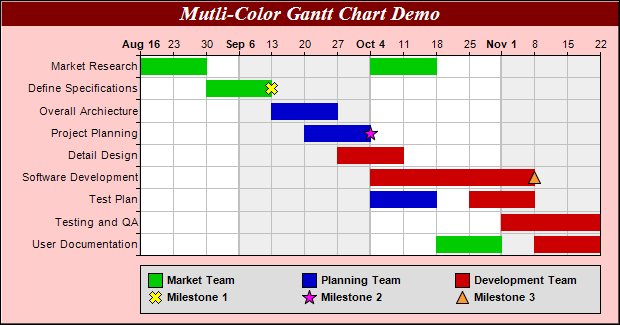require("chartdirector")
class ColorganttController < ApplicationController
def index()
@title = "Multi-Color Gantt Chart"
@ctrl_file = File.expand_path(__FILE__)
@noOfCharts = 1
render :template => "templates/chartview"
end
#
# Render and deliver the chart
#
def getchart()
# The tasks for the gantt chart
labels = ["Market Research", "Define Specifications", "Overall Archiecture",
"Project Planning", "Detail Design", "Software Development", "Test Plan",
"Testing and QA", "User Documentation"]
# The task index, start date, end date and color for each bar
taskNo = [0, 0, 1, 2, 3, 4, 5, 6, 6, 7, 8, 8]
startDate = [Time.mktime(2004, 8, 16), Time.mktime(2004, 10, 4), Time.mktime(2004, 8, 30),
Time.mktime(2004, 9, 13), Time.mktime(2004, 9, 20), Time.mktime(2004, 9, 27),
Time.mktime(2004, 10, 4), Time.mktime(2004, 10, 4), Time.mktime(2004, 10, 25),
Time.mktime(2004, 11, 1), Time.mktime(2004, 10, 18), Time.mktime(2004, 11, 8)]
endDate = [Time.mktime(2004, 8, 30), Time.mktime(2004, 10, 18), Time.mktime(2004, 9, 13),
Time.mktime(2004, 9, 27), Time.mktime(2004, 10, 4), Time.mktime(2004, 10, 11),
Time.mktime(2004, 11, 8), Time.mktime(2004, 10, 18), Time.mktime(2004, 11, 8),
Time.mktime(2004, 11, 22), Time.mktime(2004, 11, 1), Time.mktime(2004, 11, 22)]
colors = [0x00cc00, 0x00cc00, 0x00cc00, 0x0000cc, 0x0000cc, 0xcc0000, 0xcc0000, 0x0000cc,
0xcc0000, 0xcc0000, 0x00cc00, 0xcc0000]
# Create a XYChart object of size 620 x 325 pixels. Set background color to light red
# (0xffcccc), with 1 pixel 3D border effect.
c = ChartDirector::XYChart.new(620, 325, 0xffcccc, 0x000000, 1)
# Add a title to the chart using 15 points Times Bold Itatic font, with white (ffffff) text
# on a dark red (800000) background
c.addTitle("Mutli-Color Gantt Chart Demo", "timesbi.ttf", 15, 0xffffff).setBackground(
0x800000)
# Set the plotarea at (140, 55) and of size 460 x 200 pixels. Use alternative white/grey
# background. Enable both horizontal and vertical grids by setting their colors to grey
# (c0c0c0). Set vertical major grid (represents month boundaries) 2 pixels in width
c.setPlotArea(140, 55, 460, 200, 0xffffff, 0xeeeeee, ChartDirector::LineColor, 0xc0c0c0,
0xc0c0c0).setGridWidth(2, 1, 1, 1)
# swap the x and y axes to create a horziontal box-whisker chart
c.swapXY()
# Set the y-axis scale to be date scale from Aug 16, 2004 to Nov 22, 2004, with ticks every
# 7 days (1 week)
c.yAxis().setDateScale(Time.mktime(2004, 8, 16), Time.mktime(2004, 11, 22), 86400 * 7)
# Set multi-style axis label formatting. Month labels are in Arial Bold font in "mmm d"
# format. Weekly labels just show the day of month and use minor tick (by using '-' as first
# character of format string).
c.yAxis().setMultiFormat(ChartDirector::StartOfMonthFilter(),
"<*font=arialbd.ttf*>{value|mmm d}", ChartDirector::StartOfDayFilter(), "-{value|d}")
# Set the y-axis to shown on the top (right + swapXY = top)
c.setYAxisOnRight()
# Set the labels on the x axis
c.xAxis().setLabels(labels)
# Reverse the x-axis scale so that it points downwards.
c.xAxis().setReverse()
# Set the horizontal ticks and grid lines to be between the bars
c.xAxis().setTickOffset(0.5)
# Add some symbols to the chart to represent milestones. The symbols are added using scatter
# layers. We need to specify the task index, date, name, symbol shape, size and color.
c.addScatterLayer([1], [Time.mktime(2004, 9, 13)], "Milestone 1",
ChartDirector::Cross2Shape(), 13, 0xffff00)
c.addScatterLayer([3], [Time.mktime(2004, 10, 4)], "Milestone 2", ChartDirector::StarShape(5
), 15, 0xff00ff)
c.addScatterLayer([5], [Time.mktime(2004, 11, 8)], "Milestone 3",
ChartDirector::TriangleSymbol, 13, 0xff9933)
# Add a multi-color box-whisker layer to represent the gantt bars
layer = c.addBoxWhiskerLayer2(startDate, endDate, nil, nil, nil, colors)
layer.setXData(taskNo)
layer.setBorderColor(ChartDirector::SameAsMainColor)
# Divide the plot area height ( = 200 in this chart) by the number of tasks to get the
# height of each slot. Use 80% of that as the bar height.
layer.setDataWidth((200 * 4 / 5 / labels.length).to_i)
# Add a legend box at (140, 265) - bottom of the plot area. Use 8pt Arial Bold as the font
# with auto-grid layout. Set the width to the same width as the plot area. Set the
# backgorund to grey (dddddd).
legendBox = c.addLegend2(140, 265, ChartDirector::AutoGrid, "arialbd.ttf", 8)
legendBox.setWidth(461)
legendBox.setBackground(0xdddddd)
# The keys for the scatter layers (milestone symbols) will automatically be added to the
# legend box. We just need to add keys to show the meanings of the bar colors.
legendBox.addKey("Market Team", 0x00cc00)
legendBox.addKey("Planning Team", 0x0000cc)
legendBox.addKey("Development Team", 0xcc0000)
# Output the chart
send_data(c.makeChart2(ChartDirector::PNG), :type => "image/png", :disposition => "inline")
end
end |
